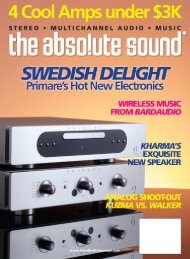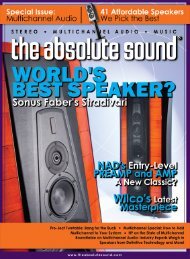The Cutting Edge
The Cutting Edge
The Cutting Edge
- No tags were found...
You also want an ePaper? Increase the reach of your titles
YUMPU automatically turns print PDFs into web optimized ePapers that Google loves.
L E T T E R Sother companies, like EMM Labs, maintainthat DSD architecture is essential topreserving the information in the signal.<strong>The</strong>re is a similar dichotomy ofviews on the software side. DeutscheGrammophon still uses PCM for itsSACDs, e.g. Kleiber/Mahler 5 and 7,whereas Channel Classics, MobileFidelity, Groove Note, Telarc, etc. useDSD throughout.I’d be grateful if you could throwsome light on this matter. An engineerat Esoteric actually said that panel testsrevealed that there was a preference forPCM over DSD, even with SACD. Ialways thought that decimation of ananalog waveform resulted in a loss oflow-level information—compare analogvinyl with digital vinyl.I look forward to your response andguidance.Dr. N. KumarRobert Harley replies: As you note,some SACD players convert the DirectStream Digital (DSD) bitstream from anSACD into linear pulse-code modulation(PCM) before the conversion to analog.One of DSD’s advantages over PCMis the lack of a need for a digital filter. Infact, it is possible to turn the DSD bitstreaminto music with a single capacitor(DSD D/A converters are more complexin practice, but not much). On theother hand, designers have a considerablywider range of choices in PCM digital-to-analogconverters. Some believethe degradation introduced by the digitalfilter is a worthwhile tradeoff foraccess to high-quality PCM DACs.More on Chesky and Apple’s iPodMay I get something off my chest? It concernsDavid Chesky’s surprising and trulyoutrageous letter in Issue 156. I agreecompletely with Robert Harley’s response,but as a classically trained composer I havea somewhat different perspective.Chesky asserts that “music is just theorganization of sound.” Well, no, it isn’t. Itis the organization of sound for a particularpurpose: that of expressivity. To achieve thatgoal—to make music that moves people—composers have an array of tools at their disposal.<strong>The</strong>se include form (which differentiatesa song from a fugue from a symphony);melodic and rhythmic themes; theuse of repetition to imbue a sense offamiliarity, combined with equal partsvariety to create surprise and avoid predictability;and tension (generated byvarious means) that is satisfied, leadingto repose. “Tonality,” as Chesky pointsout, is certainly also one of the composer’stools, but it is far from the only oreven the most important one. Bach is stillBach even when, as we have seen over thecenturies, his work is transcribed to a verydifferent tone color. <strong>The</strong> music remainstimelessly powerful because, regardless ofthe nature or quality of the instrument(s)playing it, it embodies the above qualitiesin such abundance and with exquisite craft.If, as Chesky would have us believe,“it is about the sound,” then a steady-stategorgeous tone—say, a sustained noteplayed on a Stradivarius—would be compellingin some way. It isn’t. To the contrary,I can think of nothing more boringor ultimately irritating. A painter chooseshis colors carefully, but knows that coloralone cannot create a work of art. <strong>The</strong>reare many other elements involved, andcolor, like sound, is in their service. I suspectthat Chesky, a composer whom Irespect, knows this well. But there is nosuch evidence in his letter.Sound plays two roles in our world. Itis, as discussed above, a compositionaltool used to shape the emotional makeupof a piece of music. It is also the means bywhich we perceive all music. Chesky isright that we, as reviewers, focus more onthe latter role. <strong>The</strong> reason is that even if asystem does not get the “tonality” completelyright, music can still be involvingand moving, so long as the other elementsof expressivity are accessible. (RHgave a splendid example of this in hiscomment.) To render these elementsaccessible, a system must possess onlyreasonable fidelity and sufficiently lowdistortion. An iPod in full compressionmode fails these basic requirements—distortionis high and dynamic range is solimited that any tension and repose (touse just one example) created throughchanging dynamics is obliterated. But, asRH points out, when used properly aniPod is perfectly capable of delivering thebasic elements built into the music by thecomposer. And that is why, despite tonalrestrictions, it and other sub-perfect systemscan enjoin the listener to the music.Where does this leave the high end?Where it has always been. Superior systemsare able to deliver more of the composer’sintent, more of the performer’sinterpretation, and, yes, more of the soundwe’d hear if we were listening to the sameperformance live. But this last benefitwould mean little if it weren’t coupledwith the first two. Remarkably, DavidChesky seems to have forgotten that.Thanks for letting me vent. I’ll goback to work now!Alan Taffel, TAS contributing writerMediaeval Philosopher?At the risk of sounding like a mediaevalphilosopher, I would like to clarify thediscussion occasioned by Robert Harley’sarticle “<strong>The</strong> Audiophile iPod” [Issue155]. Or maybe I should, Socrates-like,ask, which music, stupid? Of course Irealize that discussing essences, which iswhat this letter is doing, starts one downa slippery slope. Still, I believe that eventhough both bicycles and airplanes arevehicles, most people can tell the differencebetween them. It is to them that Ioffer this letter.Let us for the moment skip the questionof Platonic essences and not ponderwhat, say, Brahms’ First Symphonysounded like in Brahms’ head. For ourpurposes let us assume that the music isthe way the Berlin Philharmonic plays itunder the baton of one of our best conductors.When we reproduce it via theworld’s best sound system using SACD(you put it together), we obtain a reasonablefacsimile of the music, but not quitethe music. But for our discussion, let’s callthat the music. Let us now imagine thatwe omit every second byte from the CD(or compress it in another way—themethod doesn’t matter). It will, of course,still sound like Brahms’ First, but someonewith acute hearing would notice thatit lacks some overtones, some spatialclues, some tonal clarity, some ambience,some “continuousness.” <strong>The</strong> general publicmay barely notice that anything isamiss. Let us now compress the CD evenmore and listen to it via a portable radio.10 THE ABSOLUTE SOUND ■ FEBRUARY 2006










